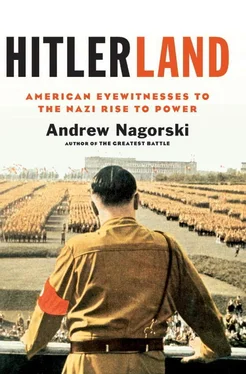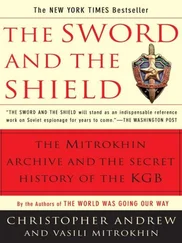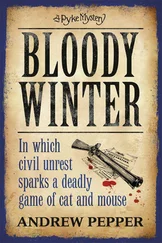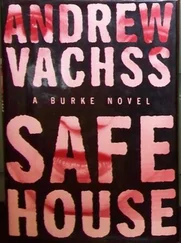By then, Gibbs was keenly aware of several waiters hovering around their table. He suggested they move to a quiet corner. “We are having an audience,” he pointed out.
Once they had switched tables, the American woman talked about Hitler, whom she knew and admired. “He is all for peace,” she declared. “Foreigners don’t believe in his sincerity. But I’m certain he wants to make a friendship with France. It is his strongest wish… Why doesn’t France accept the offer?”
Gibbs was hardly reassured, but he was convinced that the American woman was utterly sincere in her belief that Hitler and his followers wanted nothing but peace. Like Martha Dodd, she felt the new Germany and its leaders were misunderstood and unfairly maligned—and no one more so than Adolf Hitler.
7

Dancing with Nazis
On Saturday, June 30, 1934, Martha Dodd drove off early with her date, someone she identified as “a young secretary in a foreign embassy,” in a Ford roadster, with the top down, to a private lake in Gross Glienicke on the outskirts of Berlin. It was a beautiful, warm, sunny day, and she and her companion spent it on the lakeside beach, working on getting as much of a suntan as possible, knowing that summer doesn’t normally last long in northern Europe. In the late afternoon, the couple began slowly driving back to the city, “our heads giddy and our bodies burning from the sun,” as Martha recalled, perfectly content. “We were not thinking of yesterday or tomorrow, of the Nazis or of politics.”
They drove into the city at six. “I pulled down my skirt and sat up straight and proper as befits a diplomat’s daughter,” she wrote. But something looked and felt different in the German capital; the atmosphere had changed since their departure that morning. There were fewer people on the streets, mostly clustered in small groups, and, as they got closer to the center, they saw an unusual number of army trucks and machine guns, along with soldiers, SS men and Nazi police. The normally ubiquitous SA troops—the Brownshirts—were nowhere to be seen. Reaching Tiergartenstrasse, they saw that regular traffic was banned completely, and only their diplomatic plates got them through the thickening military and police checkpoints. The young diplomat dropped Martha off near her father’s ambassadorial residence, and then quickly drove to his embassy to find out what accounted for the tense atmosphere.
With the sun still beating down hard on her, Martha rushed to her father’s residence, feeling slightly dizzy, her eyes briefly blinded as she entered what looked to her like a dark house. She started up the stairs and saw the murky outline of her brother Bill.
“Martha, is that you?” he asked. “Where have you been? We were worried about you. Von Schleicher has been shot. We don’t know what is happening. There is martial law in Berlin.”
General Kurt von Schleicher had served as defense minister and then briefly as the last chancellor before Hitler came to power. He had pursued a policy of trying to split the Nazis by offering Gregor Strasser, the head of the “socialist” faction and a possible rival to Hitler, the post of vice chancellor. Schleicher was one of the politicians who had assured the AP’s Louis Lochner and other correspondents that his government was succeeding in reestablishing “internal peace.” On that morning of June 30 while Martha Dodd and her date were on their beach outing, SS men had arrived at Schleicher’s villa, rung the bell and shot him dead when he opened the door. They then shot his wife as well. At noon, Gregor Strasser was arrested at his house in Berlin and brought to the Gestapo prison on Prinz Albrechtstrasse, where he was shot a few hours later. Strasser had never accepted Schleicher’s offer to join his government and he had withdrawn from politics altogether, but that wasn’t enough to save him from Hitler’s wrath.
Those murders in Berlin were only one part of the bloody score-settling known as the “Night of the Long Knives.” Bullet-ridden bodies were left scattered in houses and prisons across Germany. Henry Mann, the Berlin representative of the National City Bank, found the body of one of his neighbors on his front steps; the victim had been lured out of his house and murdered in front of the American’s house. The body lay there for an entire day before the police came and took it away, instructing Mann’s servants to wash up the blood. Mann had earlier expressed the belief to Ambassador Dodd that he and other American bankers could work with Germany’s new rulers. But as Dodd noted in his diary, Mann “showed no patience with the Hitler regime now.”
The primary targets on June 30 were the leaders of the SA, the Storm Troopers who had provided the muscle for Hitler during his rise to power. In particular, tensions had been growing between the Reichswehr, the regular army, and Ernst Röhm, the flamboyant head of the SA, whose numbers had swelled to 2.5 million after the Nazis came to power. Röhm was a famed veteran of the movement, who had teamed up with Hitler even before the 1923 Beer Hall Putsch.
The Brownshirts were responsible for much of the violence that followed Hitler’s rise to power—the attacks on Jews, Socialists and anyone else seen to be an opponent of the regime, along with the random American or other foreigner who failed to greet the Brownshirts with a Nazi salute. While there was no doubt that they saw themselves as carrying out Hitler’s will, the Nazi ruler would later claim that they were threatening to spin out of control. He was receiving constant complaints from the Army, and even from the ailing President Hindenburg, about their lack of discipline. And Röhm was increasingly defiant, portraying his thugs as the vanguard of an ongoing revolution. “The SA and the SS will not allow the German Revolution to fall asleep or be betrayed half-way there by non-fighters,” he proclaimed, vowing to carry on “our struggle.” Hitler responded in blunt terms, although not mentioning Röhm by name. “Only fools thought the revolution was not over,” he declared.
The opulent living of the SA leaders, with widespread stories of heavy drinking and open homosexuality, hardly helped their cause. Röhm occupied a villa on Prinzregentenplatz in Munich, outfitted with centuries-old Florentine mirrors and French armchairs. A truce negotiated between the Reichswehr and the SA in early 1934 did little to lessen the rising tensions. Early in the morning on June 30, Hitler personally led a small armed contingent of police that drove in three cars from Munich to Bad Wiessee, the lakeside resort where Röhm and other SA leaders were sleeping off another night of partying.
Breaking into Röhm’s room, they declared him a traitor; in another room, they found Edmund Heines, the leader of the Breslau SA, in bed with a young male lover. Rounding up Röhm’s contingent, they took them back to a Munich prison in a bus. Several were shot immediately. Hitler initially appeared undecided about his old comrade Röhm, and it was only the next day that the SA leader was offered a pistol so he could shoot himself. He refused, and two SS men dispatched him. The regime issued a terse announcement about the man who was once a key figure in Hitler’s rise to power: “The former Chief of Staff Röhm was given the opportunity to draw the consequences of his treacherous behavior. He did not do so and was thereupon shot.”
Appearing at the Propaganda Ministry on that same day, Hermann Goering told a group of hastily assembled foreign correspondents that the Nazis were forced to act to prevent a planned rebellion against Hitler. As the Chicago Tribune ’s Sigrid Schultz recalled, the Luftwaffe (Air Force) commander had arrived “in full regalia, with his officers, strutting as stiffly as he could.” After making his terse declaration, Goering started to march out, but, spotting Schultz, whom he knew from earlier social encounters, he stopped short. “And by the way, General von Schleicher was shot, trying to escape,” he told her loudly. He then looked at her “piercingly,” Schultz recalled. It was his way of saying, she concluded, that the Nazi brass could get away with anything they wanted.
Читать дальше












